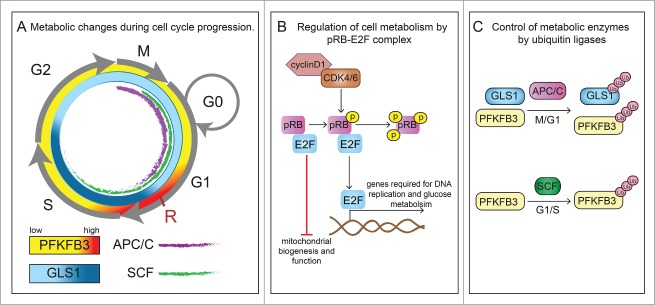Figure 1.
Crosstalk between cell cycle regulators and cellular metabolism. (A) Transitions between phases of the cell cycle (G1, S, G2 and M) are orchestrated by cell cycle activators and inhibitors. In particular, the transition from G1 to the S-phase is of high importance for the regulation of proliferation and is controlled by cyclins (cyclinD), cyclin-dependent kinase (CDK) complexes, E2F family of transcription factors and the retinoblastoma protein (pRB) family members and E3 ubiquitin ligases (see panels B and C). At late G1, a nutrient-sensitive cell growth checkpoint (labeled as R) controls progression to S phase, and enables the cell to complete cell division, but only when sufficient nutrients are available. The glycolytic activator 6-phosphofructo-2-kinase/fructose-2,6-bisphosphatase 3 (PFKFB3) is transiently upregulated at this checkpoint (symbolized by higher intensity red color). Similarly, glutaminolysis is also critical for G1-to-S transition and in addition is also important for S to G2-M progression (symbolized by higher intensity blue color reflecting glutaminase1 (GLS1) activity). Furthermore, anaphase-promoting complex (APC/C) (purple) and Skp1/Cullin/F-box (SCF) (green) control the activities of PFKFB3 and GLS1 during the different stages of the cell cycle. (B) In response to mitogens, signaling pathway kinases convey proliferative signals to activate expression of cyclins. Enzymatically active complexes of cyclins and CDKs sequentially phosphorylate pRB family members. Binding of non-phosphorylated pRb to E2F prevents the transition from G1 to S-phase, induces cell quiescence and represses expression of genes involved in mitochondria biogenesis and function. However, phosphorylation of pRB releases its binding from E2F and thus inhibitory function and allows entry into S-phase. Activation of E2F not only leads to transcription of genes involved in cell cycle progression (e.g., cyclin E) but also enzymes involved in glucose metabolism (PFKFB). (C) Further crosstalk from the cell cycle back to metabolism is exemplified by the observation that APC/C, which is active during the M and G1 phase (indicated in the cell cycle scheme in panel A by a purple inner line) promotes the proteasomal degradation of PFKFB3 and glutaminase 1 (GLS1), while the ubiquitin ligase SCF, active during G1 and S phase (indicated in the cell cycle scheme in panel A by a green inner line), targets only PFKFB3.

